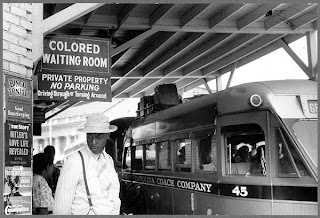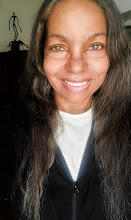Jim Crow said, "No!" Well, the movement said, "Yes!"
Rosa Parks, Martin Luther King and Diane Nash were among civil rights activists who successfully led to the end of oppressive Jim Crow practices on America's public transportation systems through the Montgomery Bus Boycott in city bus transportation and the Freedom Riders on America's highways.
Forget about riding together!
Under Jim Crow domination, black and nonwhite babies couldn't enter the world via segregated hospitals. Black and nonwhite customers couldn't try on clothing in segregated department stores. And dead black and nonwhite bodies were laid to rest different cemeteries.
Forget about riding together!
Under Jim Crow domination, black and nonwhite babies couldn't enter the world via segregated hospitals. Black and nonwhite customers couldn't try on clothing in segregated department stores. And dead black and nonwhite bodies were laid to rest different cemeteries.
Discrimination and racial oppression was not always about color, but about difference and misunderstanding.
Rights as basic as driving on certain highways, using restrooms while traveling, eating during a trip, sleeping at hotels and rest stops at roadside parks or seeking medical attention if involved in an accident were denied races of color and some races of different religion, language and culture, regardless of color, depending on the attitude of the community through which they were traveling. These were the signs of the times.
 No Latinos | ||||||
No Mexicans
No Jews
|
This is not ancient history as many may wish to believe. The denial of human rights, taking place even to this day, is a carryover from the old Jim Crow laws that had their origin during past centuries. Traditions die hard and, with the help of insensitive people, some find a way of mutating into less obvious offenses. But before we jump to today, let examine our topic as it affected thousands throughout the 1960s.
In the case of Jim Crow city bus services, the driver decided who sat down and who stood, and where customers entered or existed the bus. That constituted Jim Crow laws, exactly the same laws that regulated other pseudo public facilities like restrooms, where people in charge of the place made the decisions as to whom would be allowed to use the service, the entrance they would be allowed to enter and leave and whether or not and how their waiting room and restroom needs would be accommodated.
Decisions on access to facilities, accommodations and services were based on race, skin color or ethnicity, as Jim Crow laws applied . People of most ethnic groups--African American, Asian, Hispanic, Mediterranean, Jewish, Native American and others, many with white skin--could not pass the subjective racial test of Jim Crow law sympathizers. Colored was the category reserved for those who were of a dark-skinned, other non-white ethnicity, foreign undesirable groups, and people known to have at least one drop of African blood.
Jim Crow laws established separate but equal in (Plessy v Ferguson 1896). Businesses were obligated to provide facilities for all races and ethnic groups. Although Plessy was intended to prohibit black rights, the law also was applied to other people who did not fit the definition of white, and businesses serving whites only were not obligated to provide restrooms for patrons they considered to be non-white.
Although U.S. airline travel was not officially segregated, the price of tickets kept most poor people off of airplanes. However, African Americans who could afford to fly were often bumped from their flights by the airlines in favor of a white passenger who needed the same schedule. African American airline passengers also were moved to undesirable seats if a white passenger either wanted the seat or refused to sit beside a black passenger. Because there was an internationally famous entertainer in the music and movie business in my family, I heard stories about his travel difficulties. Rather than tolerate irregular treatment on his concert tours, he hired private airplanes for himself, his band, cast and staff.
Black and colored female domestic workers were segregated by race and subject to unwanted sexual advances in homes of their employers. Economic intimidation was used to discourage these female workers from complaining, and if they did protest, their men, children, churches and communities were terrorized or burned in retaliation.
I was only six years old when I began to understand that Rosa Parks, Montgomery Bus Boycott, Dr. Martin Luther King, Jr., and the rest of them were doing something important for us, something they were giving their full concentration, a thought process shared by my mother and Rosa Parks, and others involved in important work, as well as ordinary daily tasks. "If you think enough of a thing to do it," I can hear my mother's voice echoing in my head as I write. "Then you should do it as well as you can or leave it to someone willing to give it their full attention."
"There is amazing power in unity," Martin Luther King said of the Montgomery Bus Boycott."
 Rosa Parks: A Life by Douglas Brinkley |
 |
| Holt McDougal Library: Freedom Walkers: The Story of the Montgomery Bus Boycott Grades 6-8 |
Greyhound Bus a few times on out-of-town trips with my mother and I didn't like the noise or fumes. But for the Freedom Walkers, as the Montgomery protesters became known, the reason for staying off of city buses during the Montgomery Bus Boycott was much more significant than my childish notion of not liking to ride buses.
Freedom Walkers were those who refused to ride Alabama buses during the Montgomery Bus Boycott. In Freedom Walkers: The Story of the Montgomery Bus Boycott by Russell Freedman, the School Library Journal credits Freedman with excellent prose, a rich selection of photographs, extensive chapter notes and a large annotated bibliography. Many of the photographs in this book are the boycott images I remember from magazines of the time, particularly Life Magazine.
by Russell Freedman, the School Library Journal credits Freedman with excellent prose, a rich selection of photographs, extensive chapter notes and a large annotated bibliography. Many of the photographs in this book are the boycott images I remember from magazines of the time, particularly Life Magazine.
The Montgomery Bus Boycott, a movement to equalize local transportation in American cities, helped to dismantle Jim Crow laws across the nation.
 |
| Rosa Parks & Martin Luther King Montgomery Bus Boycott Mugshot |
In 1954, the same year of Rosa Parks led the Montgomery Bus Boycott, the Supreme Court ruled on Brown v. Board of Education and the Civil Rights Movement. I had been unable to read any part of the articles, not having yet entered first grade. However, one year later after the Montgomery Bus Boycott, with my mother's assistance, I was picking my way through new articles about Rosa Parks and older coverage of Brown. Since that time, I have read extensively from a scholarly perspective on the Civil Rights Movement and also examined resources available for young students.
 |
| Thurgood Marshall after Brown v the Board of Education Students on Steps of the U.S. Supreme Court 1954 |
Racial lines were already being drawn in places where some members of our family lived in nearby towns. When my cousin died in Iola, Texas, a small town about 30 miles away, just one month after the Brown ruling, her school was closed when the town's political officials and school leaders invoked a statute to close its school for colored due to its small number of black students. For the next ten years, my cousins were forced to drive themselves to schools that would take them as far away as 30 miles away in beat-up old cars their father kept running with his mechanical skills. Again, transportation played a crucial part in Jim Crow laws.
 |
| Freedom Riders: 1961 and the Struggle for Racial Justice |
Nine years after the Montgomery Bus Boycott, Freedom Riders replaced Freedom Walkers that grew out of the Montgomery Bus Boycott and further bolstered the Brown decision with a continuation of demonstrations against all Jim Crow.
 |
| Diane Nash (center) Leads Demonstration Against Jim Crow Laws Nashville, Tennessee 1962 |
for the next ten years, my younger cousins commuted to black schools in and around their county and graduated until President Lyndon Johnson signed the Civil Rights Act of 1964 and the younger ones were officially invited to attend the white school in their town, where they graduated and all went on to attend and graduate from college.
Lyndon Johnson Signs Civil Rights Act of 1964
|
Hard Cover
Amazon Kindle
|
 |
| Sunny Nash |
Sunny Nash’s book is recognized by the Association of American University Presses as essential for understanding U.S. race relations. Nash's book is also listed in the Bibliographic Guide for black studies at the Schomburg Center for Research in Black Culture in New York; and recommended for Native American collections by the Miami-Dade Public Library System in Florida. Nash uses her book to write articles and blogs on race relations in America through topics relating to her life--from music, film, early radio and television, entertainment, social media, Internet technology, publishing, journalism, sports, education, employment, the military, fashion, performing arts, literature, women's issues, adolescence and childhood, equal rights, social and political movements--past and present—to today's post-racism.
ushistory.org home
ushistory.org home
© 2014 Sunny Nash. All Rights Reserved Worldwide.
www.sunnynash.blogspot.com
www.sunnynash.blogspot.com
~Thank You~














No comments:
Post a Comment
Note: Only a member of this blog may post a comment.